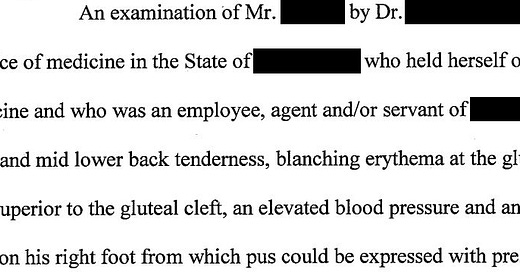A 51-year-old man presented to the ED with multiple symptoms.
His primary medical comorbidities included diabetes and hypertension.
His labs demonstrated a leukocytosis, hyperglycemia, and hyponatremia.
No specific focus of infection was found on his UA or chest x-ray.
Fluids and antibiotics were started.
The ED physician admitted the patient to the hospitalist.
Based on this excerpt from her physical exam, it was clear that there was strong suspicion for skin/soft tissue infection:
The internal medicine team was suspicious of an epidural abscess.
They ordered MRIs and worked with radiology to make sure they would be done that day, despite ordering them late in the afternoon.
Subscribers get access to the entire archive of cases and a new curated case every week.
Neurosurgery was immediately paged.
Given that the patient had been having symptoms for weeks, the neurosurgeon felt that doing an emergency operation that night would not be beneficial.
He saw the patient the next morning and took him to the OR in the afternoon.
On post-op day #1 and #2, he was noted to have worsening weakness in his legs.
It progressed to the point that he could not move his legs at all.
On POD #3 he was sent for a repeat lumbar MRI and (for the first time) a thoracic MRI.
He was taken back to the OR, but was ultimately rendered paraplegic.
The patient contacted a law firm.
They sued the neurosurgeon, the hospitalists, and the hospital.
They did not sue the ER doctor.
Expert opinions signed by a neurosurgeon and a nurse contained the exact same 5 allegations of negligence as shown above.
The patient died a few months into the lawsuit.
After the patient’s death, his estate settled with all parties.
"Thanks for all the work you do in putting these together. Always so interesting to look at cases and see how things unfold. The cases also make great teaching points for the residents on rounds."
MedMalReviewer Analysis:
This case is a perfect example of a classic mistake, and an illustration of one of the most important points I’ve learned from reading malpractice cases: If a patient has leg weakness and you’re worried about a spinal epidural abscess (SEA), you probably need to image both the thoracic and lumbar spine. Many clinicians make the mistake of thinking “Legs = Lumbar”, and miss thoracic lesions.
Some experts argue that any concern for SEA should trigger an MRI of the entire spine. There’s also a convincing argument that once an SEA is identified at *any* level, the patient should be sent back to the MRI scanner to image the rest of the spine. SEAs can present at multiple independent levels (called “skip lesions”) and can be difficult to catch.
I was impressed that the ED and medicine teams were quick to recognize concern for SEA. These patients often present with a long list of vague, subacute complaints. It’s easy to be concerned for SEA on a boards question that describes only fever and back pain, but in reality the clues to the diagnosis are often hidden in a long list of complaints and can be difficult to piece together.
We’re accustomed to seeing patients with emergencies that unfold over minutes or a few hours. SEA is an emergency with symptoms that can unfold over several weeks. Don’t be fooled by the relatively slow progression of this emergency.
I think there is a valid criticism here about the delay in diagnosing the thoracic lesion. In my opinion this primarily falls on the neurosurgeon. The patient had some preserved leg movement after the first operation, but then spent multiple days with worsening paralysis, during which no action was taken. I don’t think the hospitalists should bear much blame here, the neurosurgeon is responsible for rounding on his post-op patient and realizing that something is amiss.
The criticism about the time to obtain MRIs is unwarranted. This is a standard timeline to get an inpatient MRI in any hospital in America. These delays did not contribute to his injury.
Here are other related malpractice cases that drive home the same points:












I wish I could always get an MRI within 4 hours of ordering without calling a stroke code
I’ve only seen this after a PM&R “Spine Specialist” performed their epidural steroid injections on a Diabetic patient, for Pain Management. Btw-That irresponsible physician told the patient to go show up at a Neurosurgeon’s office at 4:30pm on a Friday. Just when you think you’ve heard it all….